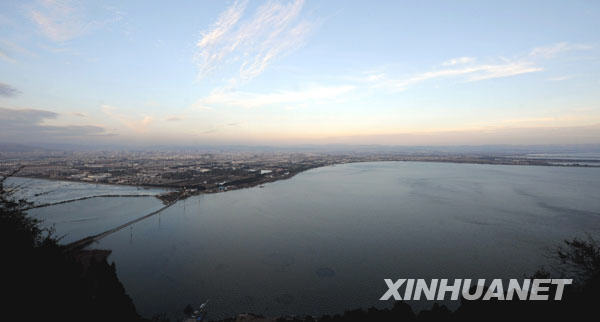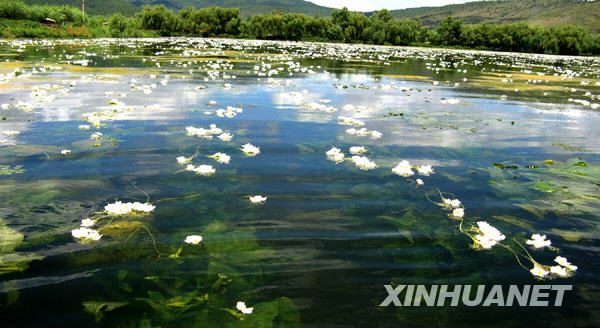Gains of a green drive
Save the splendor of Yunnan
Yunnan, situated in the southwest plateau of China, was dubbed the south of colorful clouds for its varied and glorious skyscape. But Dianchi, the largest freshwater lake in the province and the sixth largest in the nation, was once seriously polluted by farming waste, landfills and household refuse dumping. The first round of environmental remediation was started the lake in the 1980s but had little effect.
 |
| Photo taken on January 20, 2010 shows Dianchi, the largest freshwater lake in Yunnan Province. |
In 2008 the efforts were intensified. Laws were made to protect this pearl of the plateau. Particular persons were appointed to be in charge of different stretches of rivers flowing into the lake. In less than two years the fund spent on the lake doubled the total sum over the previous two decades. These measures delivered instant results. Of 35 rivers pouring into the lake, 26 have seen a reduction of pollutants, remarkably so in 15 of them.
Besides Dianchi, another eight lakes in the province are also undergoing pollution management. By September 2009, the investment on them exceeded RMB 13.1 billion, with that on Dianchi taking a lion’s share of RMB 9.4 billion. The latest water monitoring results showed that water quality remained stable in all but one of these lakes; some, including Dianchi, were improved.
 |
| Photo taken in March, 2009 shows Dianchi, the largest freshwater lake in Yunnan Province. |
The instinct to protect
In addition to water governance, the province has also issued "Lijiang Declaration of Biodiversity Conservation in Northwest Yunnan", established the "Joint Conference System of Biodiversity Conservation in Northwest Yunnan", and organized a biodiversity assessment.
Yunnan is well known for its diversity in biology, boasting 20,000 species of higher animals and plants and a rich and complex eco-system. Thus far, a complete bio-diversity database has been established, assessing 129 counties by five indicators ranging from species richness, diversity of ecosystem types, completeness of vertical stratification of vegetation, endemism, and extent of biological invasion.
Home to dozens of ethnic groups, the countryside in Yunnan boasts great scenery but is fragile in the face of pollution. Therefore, the province has carried out a series of actions to save the wholesomeness of its rural life, including protection for drinking water sources, reining industrial pollution and preventing overuse of fertilizer and pesticides.
Currently 10 towns named China's most beautiful are in Yunnan. "We need to tell citizens that it's a shame to destroy nature, and a duty to protect it," wrote Governor Qin Guangrong, addressing the third anniversary of the Protection Action Plan of Yunan. "The protection of nature should be instinctual to every person and every organization, reflected to every action of our daily lives."
Progress in environmental protection in western China in the past decade
- The work to abate pollution and cut emissions keeps pushing forward, and related policies are steadily upgraded.
- At present, nature reserves account for 18 percent of the territory of western regions, well above the national level.
- Pollution in major rivers in western regions has been curbed and the water quality of some rivers has been significantly improved. The State Council gave the green light to a series of water pollution control plans for the Three Gorges reservoir area and upstream, the Danjiangkou reservoir area and upstream, and the middle and upper reaches of the Yellow River.
- The central government has increased the budget for environmental protection. Since 2000, about RMB 5.2 billion has been invested in state-sponsored environmental projects in western China, funding the National Monitoring Network (radiation and surface water); the national hazardous waste and medical waste disposal facility; the central government special program on environmental protection and major pollutants emission reduction; restoration and emergency monitoring of after-disaster environment; emergency monitoring of earthquake-stricken areas; environmental law enforcement in the central and western regions; state-level nature reserves; and pollution prevention in livestock and poultry farming.
- Science and technology relevant to environmental protection received more funding. About RMB 21 million was earmarked for scientific institutions in western regions, and RMB1.7 billion were awarded to projects for water pollution control and management.
- Great importance is attached to human resources and the regional supervision system. In 2005 environmental protection supervision centers for the northwestern and southwestern regions were established, and the Northwest Institute of Nuclear and Radiation Safety Supervision Station opened its doors. Environmental protection agencies increased from 2,131 in 1999 to 3050 in 2008, up 43 percent. And their staff members rose from17,724 to 31,368, up 77 percent.
 0
0 







Go to Forum >>0 Comments